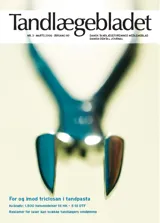Risker och nytta med triklosan i tandkräm
Triklosan ingår som antibakteriellt medel i kosmetika och hygienprodukter. Triklosan är toxiskt mot vissa fiskarter och alger och klassas som miljöfarligt. Substansen har påvisats i galla och fettvävnad hos djur. Under 1990-talet tillsattes triklosan i allt fler konsumentprodukter vilket ledde till debatt om risker och nytta. Importen av ren triklosan minskade men inte införseln av triklosantandkräm. I dag är tandkräm den dominerande exponeringskällan. Regelbunden användning av triklosantandkräm leder till att substansen kan påvisas i plasma och i bröstmjölk. Laboratorieexperiment visar att både resistens mot triklosan och nedsatt känslighet för antibiotika kan förekomma. Däremot saknas studier som belyser om dessa förändringar hos bakterier har klinisk relevans. Man har inte heller kunnat visa att användning av triklosantandkräm i kliniska korttidsstudier orsakar nedsatt känslighet eller störningar i munhålans mikroflora. Mikrobiell resistens mot antibiotika förknippad med triklosan kan dock inte uteslutas. I hygienprodukter är den högsta tillåtna koncentrationen av triklosan 0,3%. Samma halt används i tandkräm och har således inte valts ut av odontologiska skäl. Effekten av triklosantandkräm på plack och gingivit är blygsam, vilket delvis torde bero på mikrobiella biofilmers låga känslighet för antibakteriella medel. Triklosantandkräm har obetydlig effekt på initial parodontit och dess värde vid förebyggande och behandling av måttlig till svår parodontit är tveksamt. Svag klinisk effekt och potentiella risker gör att triklosan inte bör ingå i fritt försåld tandkräm.
Triclosan in toothpaste – risks and benefits: Triclosan is an antibacterial chlorinated bisphenol widely used in cosmetic formulations and hygiene products such as tooth- paste. Triclosan has been demonstrated in bile and adipose tis- sue of animals. It is toxic to fi sh and especially to algae and therefore classifi ed as harmful to the environment. Further, it may be converted to toxic dioxins when heated. Triclosan can be transmitted to man through water, air, food, and toothpaste. Regular use of toothpaste containing the substance leeds to a presence of triclosan in plasma and breast milk. During the 1990s, triclosan was included in an increasing number of consumer products, which resulted in discus- sions concerning risks and benefi ts. This lead to a de crease in the import of pure triclosan to Sweden, but not of too paste containing triclosan. Today, toothpaste is the domi- nating source of triclosan for human exposure and for en- vironmental discharge. Laboratory studies have shown that exposure of bacteria to triclosan is associated both with resistance to triclosan and reduced susceptibility to antibiotics. There is how ever no evidence that such bacterial changes have clinical rele- vance, neither have short-term clinical studies of triclosan toothpaste shown any decreased susceptibility to the agent or other disturbances in the human oral micro fl ora. Micro- bial resistance to antibiotics related to triclosan cannot be excluded, since subinhibitory concentrations may be pre- sent in humans and in the environment. Toothpaste containing the standard level of triclosan for hygiene products, 0.3 percent, has a limited effect on plaque development and gingivitis, which in part may depend on the low susceptibility of microbial biofi lms to antibacterial agents. Triclosan toothpaste has an insignifi cant effect on initial periodontitis, and its value for prevention and treat- ment of moderate and severe periodontitis is doubtful. Due to its marginal clinical value and possible risks, triclosan should not be included in toothpaste sold over the counter.


